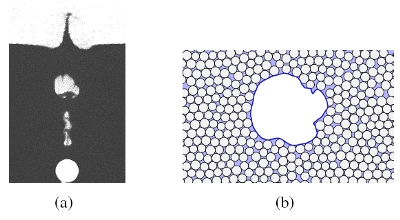A numerical study of granular flows and colloidal suspensions
We study granular systems where hydrodynamics are important. The numerical method we use was originally developed to study the granular Rayleigh-Taylor (GRT) instability where a layer of densely packed grains is positioned above a layer of air [Phys. Rev. Lett. 99, 048001 (2007)]. This model is now extended with additional interactions and features to enable it to describe related, but still different, systems. Such systems include formation of granular jets, hydrodynamic interactions in colloidal systems, and the propagation of air bubbles in a mixture of glass beads and water (three-phase flows).
Granular jets are produced when a heavy, large object is dropped on fine, loosely packed sand. Hydrodynamics is very important in the formation of such jets. Using our numerical model we have studied quite big systems and produced jets that resemble the experimentally observed jets.

As grains become smaller than about 1 μm in diameter the dynamics of the grains and their interactions with the interstitial fluid change significantly. Browninan motion must be included in the description as well as attractive Van-der-Waals forces and repulsive Coulomb forces. In most numerical descriptions of colloidal systems the hydrodynamic interactions are not considered. By adding relevant interactions to our model we will be able to investigate the importance of hydrodynamics in colloidal systems.
A numerical model for three-phase flow (grains, liquid and air) is the most recent extension of the model. In the experiment air is injected at the bottom of vertical Hele-Shaw cell containing densely packed glass beads in a water-glycerin mixture. A complicated interplay of the rising air-bubble and the surrounding grain-liquid mixture is observed. The experiments are conducted by Kong Xiang-Zhao under supervision by Prof. Kinzelbach at the Institute of Environmental Engineering, ETHZ.
